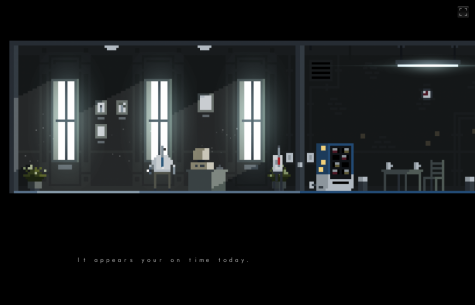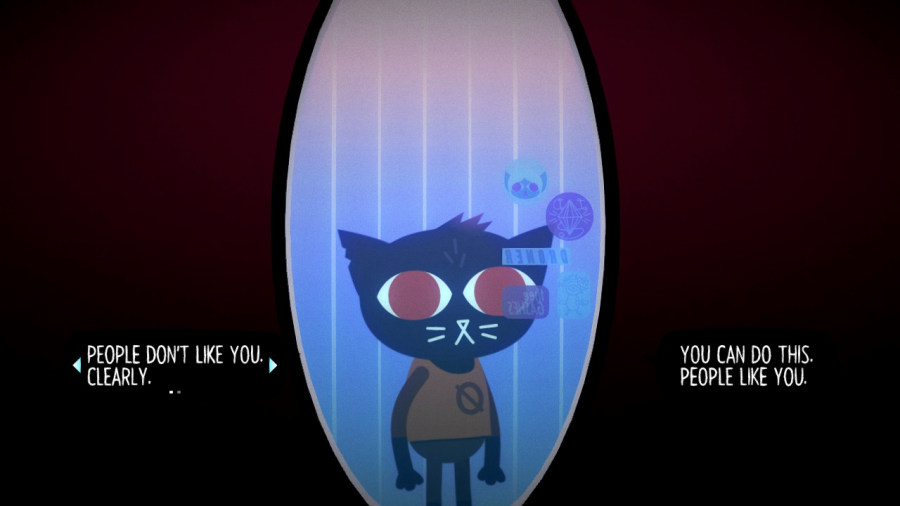Video Game Recap: Mental Health Edition
Safe Zones and Nightmare Eyes
The player is presented with options as Mae, the main character of ‘Night in the Woods’, struggles in her internal dialogue.
As we near the end of the year, we have more time to reflect on our mental health and workload. Most teachers are easing up on assignments while final exams and projects dominate the typical academic schedule. While gaming in and of itself can be a stress reliever, there are many aspects of mental health we don’t quite have experience with. In an effort to spread awareness and share struggles, many developers have transformed these experiences into gameplay.
Of the many games centered around mental illness, plenty of them attempt to convey the feelings of things that are hard to understand unless you’ve experienced them. They often do this through visualization and mechanics to invoke the emotions associated with these issues. For example, Anxiety Attacks by developer NeatWolf gives you only two main objectives: control your breathing and get to a safe zone to escape… something. You start in a beautiful bright forest, but once you lose the rhythm of your breathing, the screen begins to darken and distort and your own dark thoughts crowd the screen, and the only way to stop it is to regain control of your breath. This game not only parrots the directions commonly given for anxiety attacks—take deep, controlled breaths and find a safe space—but also shows how panic makes both those objectives infinitely harder. TIE by Tony Nowack (and a team of others) takes a less involved approach from the player, allowing them to be an observer of the nameless main character’s daily routine. Somber music and repetition guide the plot as the main character struggles through the monotony of his life—rarely hungry, always tired, and trapped in routine—as the world around becomes increasingly unrecognizable and his reality begins to fall apart.
Alongside the games that have mental illness as the focus are games that take a less aggressive approach to the issue. There are plenty of games where the characters’ struggles with mental health are either a driving force that isn’t really developed or a subplot that plays out in the background of the main story. On the other end of the spectrum is Night in the Woods, a high-rated adventure game by Infinite Fall, which treats depression as a part of life. While the main plot of the story progresses, events in Mae’s life are hint at her severe struggle with mental illness. The majority of her town seems to know her through a violent incident years prior, and she eventually describes from her point of view that during the incident everyone appeared as “dead shapes’ and she felt a deep numbness towards her own existence—revealing her actions a result of a sort of dissociative episode. Throughout the game there are moments where the plot pauses and Mae begins to question herself, suddenly negative regardless of the events that transpired around her. At some point during an outburst she claims she has “nightmare eyes,” which could be a reflection of both how people (including herself) see her after the incident and how she sees the world around her: as a nightmare. She struggles to explain to herself and those around her why and how she feels the way she does as her issues create strain in all of her relationships—and the player must witness and guide her through them while traversing the main story.

TIE, a pixelated game about depression, emphasizes the monotony of everyday life.
Overall, there are plenty of games meant to relieve stress—alongside many meant to cause it in an effort to create understanding. It’s imperative that we raise awareness about the importance of mental health without isolating or alienating those that struggle with mental illness, and interactive methods such as video games seem to be a popular means of doing so. Developers are working to show that mental attitude is never black and white, and some people struggle more than others when it comes to trying to remain positive.
She-Vaughan Edwards is a Chief Graphic Designer and Layout Editor for ‘The Science Survey’ and a Groups Section Reporter for ‘The Observatory.’...

